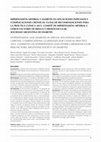Papers by Guillermo Dieuzeide
Revista de la Sociedad Argentina de Diabetes
En las personas con diabetes mellitus (DM) e hipertensión arterial (HTA), los objetivos de presió... more En las personas con diabetes mellitus (DM) e hipertensión arterial (HTA), los objetivos de presión arterial (PA) deben individualizarse considerando el riesgo cardiovascular, los potenciales efectos adversos de los fármacos antihipertensivos, y el costo y las preferencias de los pacientes. En personas con DM y elevado riesgo cardiovascular un objetivo de PA <130/80 mmHg sería apropiado si puede lograrse con seguridad. Si el riesgo cardiovascular es bajo, tratar la HTA con un objetivo <140/90 mmHg. En embarazadas con DM gestacional (DMG) e HTA preexistente, se sugiere un objetivo de PA de 110-135/85 mmHg con la finalidad de reducir el riesgo de eclampsia y minimizar el retraso de crecimiento intrauterino.
Revista de la Sociedad Argentina de Diabetes, Apr 1, 2024
¿Es superior el nivel de creatinina respecto de la presencia de albuminuria en su asociación con ... more ¿Es superior el nivel de creatinina respecto de la presencia de albuminuria en su asociación con eventos cardiovasculares en los pacientes con diabetes mellitus tipo 2? Is superior the creatinine level regarding to the presence of albuminuria in their association with cardiovascular events in patients with type 2 diabetes mellitus?

Primary Care Diabetes, Jul 1, 2014
AIMS Biphasic insulin aspart 30 allows fewer daily injections versus basal-bolus insulin regimens... more AIMS Biphasic insulin aspart 30 allows fewer daily injections versus basal-bolus insulin regimens, which may improve adherence and treatment outcome. This sub-analysis of the observational A1chieve study assessed clinical safety and effectiveness of biphasic insulin aspart 30 in people with type 2 diabetes previously receiving basal-bolus insulin regimens. METHODS A1chieve was an international, open-label, 24-week study in people with type 2 diabetes starting/switching to biphasic insulin aspart 30, insulin detemir or insulin aspart. This sub-analysis assessed patients switching from insulin glargine- or neutral protamine Hagedorn insulin-based basal-bolus insulin regimens to biphasic insulin aspart 30. RESULTS 1024 patients were included. At 24 weeks, glycated haemoglobin and fasting plasma glucose were significantly reduced from baseline in both cohorts (all p<0.001). The proportion reporting any hypoglycaemia, major hypoglycaemia or nocturnal hypoglycaemia was significantly reduced after 24 weeks (all p<0.05). No serious adverse drug reactions were reported. Both cohorts had significantly improved health-related quality of life (HRQoL; p<0.001). CONCLUSIONS 24 weeks after switching from basal-bolus insulin regimens to biphasic insulin aspart 30, glycaemic control and HRQoL were significantly improved, and hypoglycaemia was significantly reduced. This suggests that people with type 2 diabetes inadequately controlled on basal-bolus insulin regimens can consider biphasic insulin aspart 30.

International Journal of Clinical Practice, Nov 19, 2013
To implement a patient registry and collect data related to the care provided to people with type... more To implement a patient registry and collect data related to the care provided to people with type 2 diabetes in six specialized centers of three Latin American countries, measure the quality of such care using a standardized form (QUALIDIAB) that collects information on different quality of care indicators, and analyze the potential of collecting this information for improving quality of care and conducting clinical research. We collected data on clinical, metabolic and therapeutic indicators, micro- and macrovascular complications, rate of use of diagnostic and therapeutic elements and hospitalization of patients with type 2 diabetes in six diabetes centers, four in Argentina and one each in Colombia and Peru. We analyzed 1157 records from patients with type 2 diabetes (Argentina, 668; Colombia, 220; Peru, 269); 39 records were discarded because of data entry errors or inconsistencies. The data demonstrated frequency performance deficiencies in several procedures, including foot and ocular fundus examination and various cardiovascular screening tests. In contrast, HbA1c and cardiovascular risk factor assessments were performed with a greater frequency than recommended by international guidelines. Management of insulin therapy was sub-optimal, and deficiencies were also noted among diabetes education indicators. Patient registry was successfully implemented in these clinics following an interactive educational program. The data obtained provide useful information as to deficiencies in care and may be used to guide quality of care improvement efforts.

Journal of Molecular Endocrinology, Oct 1, 2005
Our objective was to search for differences in genotypes of peroxisome proliferator-activated rec... more Our objective was to search for differences in genotypes of peroxisome proliferator-activated receptor gamma (PPAR) (Pro12 Ala) and its coactivator PGC-1 (Gly482 Ser) in adolescents harboring features of metabolic syndrome. In a population-based study, we determined medical history, anthropometric variables, biochemical measurements and arterial blood pressures of 934 high-school students of Caucasian origin. We selected 220 adolescents who had systolic or diastolic blood pressures more than the 80th or less than the 20th percentiles based on the previous single set of measurements. One hundred and seventy-five adolescents completed the study and underwent two additional blood pressure measurements on different days, as well as biochemical analysis and genotyping. We found no association between insulin resistance, body mass index (BMI) and leptin levels and PPAR and PGC-1 genotypes. The 12 Ala PPAR allele was associated with increased waist-to-hip ratio (WHR) and carriers seemed to have higher diastolic blood pressure and lower pulse pressure than non-carriers, particularly in the hypertensive and overweight group. Although Ser482 Ser PGC-1 homozygotes had lower WHRs than other PGC-1 genotypes, they were more frequent in the hypertensive group than in the normotensive (44•4 vs 24•5%, P,0•03), so the 482 Ser PGC-1 allele was in our population a risk factor for hypertension independently of WHR, homeostasis model assessment of insulin resistance, BMI and Pro12 Ala PPAR variant (odds ratio=4•0, 95% confidence interval 1•5-10•6, P,0•01). Multiple regression analysis showed that age-and sex-adjusted systolic blood pressure correlated with the 482 Ser PGC-1 allele regardless of those covariates. In conclusion, the Gly482 Ser variant of the PGC-1 gene may be an independent genetic risk factor for young-onset hypertension.
Prensa médica argentina, 1984
Diabetologie und Stoffwechsel, 2016
Revista de la Sociedad Argentina de Diabetes, Nov 21, 2020

Diabetes, Jun 1, 2021
Objective: The CAPTURE study found that the prevalence of CVD in adults with T2D is approximately... more Objective: The CAPTURE study found that the prevalence of CVD in adults with T2D is approximately 1 in 3. This post hoc analysis determined the association between CVD risk factors (RF) and CVD. Methods: CAPTURE was a cross-sectional, non-interventional study in people with T2D across 13 countries. Participant data were collected during a single routine clinical visit in a primary or specialist settings between Dec 1, 2018 and Sep, 2019. A multivariable logistic regression model was used to calculate prevalence odds ratios (PORs). Results: Data were from 6369 participants with the information available for all included variables from the total CAPTURE population (N=9823). Age and CKD (assessed by eGFR) were positively associated with CVD status (both p Conclusion: The high CVD prevalence in the CAPTURE study is associated with demographics, classic CVD RF and diabetes-related variables, especially CKD. A negative association with LDL-C reflect confounding through indication for the use of lipid-lowering agents. These data support the use of antidiabetes drugs with proven CV benefit on several CV RFs in people with T2D and CVD. Disclosure A. M. Alguwaihes: Advisory Panel; Self; AstraZeneca, Boehringer Ingelheim International GmbH, Eli Lilly and Company, Novo Nordisk, Sanofi, Research Support; Self; AstraZeneca, Novo Nordisk, Speaker’s Bureau; Self; AstraZeneca, Boehringer Ingelheim International GmbH, Eli Lilly and Company, Novo Nordisk, Sanofi. C. Lengyel: Other Relationship; Self; AstraZeneca, Berlin-Chemie AG, Boehringer Ingelheim International GmbH, EGIS, KRKA, Lilly Hungaria Kft, MSD Corporation, Novartis AG, Novo Nordisk, Pfizer Inc., Richter Gedeon, Sandoz International GmbH, Sanofi-Aventis, Servier Laboratories, Teva Pharmaceutical Industries Ltd., Worwag Pharma. O. Mosenzon: Advisory Panel; Self; AstraZeneca, Boehringer Ingelheim Pharmaceuticals, Inc., BOL Pharma, Eli Lilly and Company, Merck & Co., Inc., Novo Nordisk, Sanofi, Research Support; Self; AstraZeneca, Novo Nordisk, Speaker’s Bureau; Self; AstraZeneca, Boehringer Ingelheim Pharmaceuticals, Inc., Eli Lilly and Company, Merck & Co., Inc., Novo Nordisk, Sanofi. G. T. Russo: Advisory Panel; Self; AstraZeneca, Boehringer Ingelheim International GmbH, Eli Lilly and Company, Merck Sharp & Dohme Corp., Novartis AG, Novo Nordisk, Sanofi, Speaker’s Bureau; Self; AstraZeneca, Boehringer Ingelheim International GmbH, Eli Lilly and Company, Merck Sharp & Dohme Corp., Novartis AG, Novo Nordisk, Sanofi. S. Shirabe: Other Relationship; Self; Merck Sharp & Dohme Corp., Novo Nordisk, Sumitomo Dainippon Pharma Co., Ltd. K. Urbancova: Advisory Panel; Self; AstraZeneca, Boehringer Ingelheim International GmbH, Novo Nordisk, Consultant; Self; AstraZeneca, Boehringer Ingelheim International GmbH, Eli Lilly and Company, MSD Corporation, Novo Nordisk, Speaker’s Bureau; Self; AstraZeneca, Boehringer Ingelheim International GmbH, Eli Lilly and Company, Merck & Co., Inc., MSD Corporation, Novo Nordisk, Zentiva. S. Vencio: Advisory Panel; Self; Boehringer Ingelheim International GmbH, Novartis AG, Novo Nordisk, Other Relationship; Self; Boehringer Ingelheim International GmbH, Novartis AG, Novo Nordisk, Speaker’s Bureau; Self; Boehringer Ingelheim International GmbH, Novartis AG, Novo Nordisk. G. Yadav: Employee; Self; Novo Nordisk. J. A. Leon: Advisory Panel; Self; AstraZeneca, Merck Sharp & Dohme Corp., Novartis AG, Novo Nordisk, Research Support; Self; Amgen Inc., AstraZeneca, Bristol-Myers Squibb Company, Janssen Pharmaceuticals, Inc., Merck Sharp & Dohme Corp., Novartis AG, Novo Nordisk, Sanofi, Takeda Pharmaceutical Co., Speaker’s Bureau; Self; AstraZeneca, Merck & Co., Inc., Merck Sharp & Dohme Corp., Novo Nordisk. F. Bayram: Advisory Panel; Self; Novo Nordisk A/S, Sanofi Genzyme, Consultant; Self; Lilly Diabetes, Novo Nordisk, Pfizer Inc. P. Darmon: Advisory Panel; Self; Abbott, AstraZeneca, Boehringer Ingelheim International GmbH, Eli Lilly and Company, MSD Corporation, Mundipharma International, Novartis AG, Novo Nordisk, Sanofi, Research Support; Self; Boehringer Ingelheim International GmbH, Eli Lilly and Company, Novo Nordisk, Speaker’s Bureau; Self; Abbott, AstraZeneca, Boehringer Ingelheim International GmbH, Eli Lilly and Company, MSD Corporation, Mundipharma International, Novartis AG, Novo Nordisk, Sanofi. T. Davis: Advisory Panel; Self; Merck Sharp & Dohme Corp. Speaker9s Bureau; Self; Novo Nordisk. Other Relationship; Self; Novo Nordisk. G. Dieuzeide: Advisory Panel; Self; AstraZeneca, Novo Nordisk, Roche Diagnostic USA, Sanofi. Speaker9s Bureau; Self; AstraZeneca, Novo Nordisk, Roche Diagnostic USA, Sanofi. K.T. Eriksen: Employee; Self; Novo Nordisk. T. Hong: Speaker9s Bureau; Self; AstraZeneca, Boehringer Ingelheim International GmbH, Merck Sharp & Dohme Corp., Novo Nordisk, Sanofi. T.J. Jensen: Employee; Self; Novo Nordisk. C. Lengyel: Other Relationship; Self; AstraZeneca, Berlin-Chemie AG, Boehringer Ingelheim International GmbH, EGIS, KRKA,…
Revista de la Sociedad Argentina de Diabetes, Nov 21, 2020
Trabajos Seleccionados Trabajos Seleccionados PRESENTACIONES POSTERS P8 Evaluación contemporánea ... more Trabajos Seleccionados Trabajos Seleccionados PRESENTACIONES POSTERS P8 Evaluación contemporánea del uso de medicación para la diabetes en personas con diabetes tipo 2 y enfermedad cardiovascular: un análisis preespecificado de la población argentina que participa en el estudio multinacional y transversal CAPTURE
Revista de la Sociedad Argentina de Diabetes, Dec 1, 2014
Revista de la Sociedad Argentina de Diabetes, Nov 21, 2020
DOAJ (DOAJ: Directory of Open Access Journals), Aug 1, 2022

Circulation, Nov 17, 2020
Background and aim: The association between LDL levels, CVD and the benefits of statin use are we... more Background and aim: The association between LDL levels, CVD and the benefits of statin use are well established. The CAPTURE study estimated the contemporary (2019) global prevalence of CVD and medication use in adults with type 2 diabetes across 13 countries. This post hoc analysis assessed serum lipid status and statin use in people with type 2 diabetes without CVD (NoCVD), with established CVD, and atherosclerotic CVD (AsCVD, a subgroup of CVD). Methods: CAPTURE was a multinational, cross-sectional and non-interventional study. Participant information on CVD status, serum lipid profiles, and medication use were ascertained during single routine clinical visit in primary or specialist setting. This analysis included people who had data on serum LDL-C and lipid-lowering therapies. LDL-C targets were set at <100 mg/dL (<2.6 mmol/L) and <70 mg/dL (<1.8 mmol/L) for people without and with CVD/AsCVD, respectively according to the ADA 2019 guidelines. Data were analyzed descriptively. Results: The CAPTURE study enrolled 9823 people aimed to be representative of the general type 2 diabetes population. Most (>80%) had blood LDL-C information. Mean serum levels of lipids varied across 3 groups. (Table) The overall use of any statin was 38% in the NoCVD, 53% in CVD, and 55% in AsCVD groups. In those with documented serum LDL-C levels, 48% in the NoCVD, 67% in CVD, and 66% in AsCVD groups were above LDL-C targets with statin use of 34%, 57%, and 60%, respectively in these participants. Overall, the use of ezetimibe was 3-8% in all the groups and usually in combination with a statin. PCSK9 inhibitors use was <0.1% and used only in participants with CVD. (Table) Conclusion: In conclusion, this CAPTURE post hoc analysis found that two-thirds of people with CVD and AsCVD had LDL-C levels above recommendations and only around 60% of them were on statins. Intolerability of statins might partly explain this lower than expected statin use.

Revista de la Sociedad Argentina de Diabetes, Apr 1, 2016
Introducción: la hipertensión arterial (HA) y la diabetes mellitus (DM) son enfermedades de alta ... more Introducción: la hipertensión arterial (HA) y la diabetes mellitus (DM) son enfermedades de alta prevalencia y frecuentemente asociadas. Objetivo: brindar los conocimientos para la práctica clínica que favorezca la toma de decisiones diagnósticas y terapéuticas adecuadas. Metodología: basándonos en la evidencia disponible, los grandes ensayos clínicos publicados en los últimos cuatro años y la adaptación de los recursos diagnósticos y terapéuticos de nuestro país, se elaboraron estas "Recomendaciones para la Práctica Clínica" , enfocando situaciones especiales como embarazo, niñez, adulto mayor y complicaciones crónicas. Conclusiones: la HA aumenta la progresión y el desarrollo de las complicaciones crónicas micro y macrovasculares. El impacto del tratamiento de la HA es significativo en la reducción de la morbimortalidad de las personas con DM y en la aparición y progresión de las complicaciones micro y macrovasculares. En la mayoría de los adultos con HA y DM el objetivo es alcanzar una PA (presión arterial) <140/90 mmHg. Siendo las metas menos estrictas en los adultos mayores frágiles. En personas con trasplante renal, en RAC (relación albúmina/creatinina) >300 mg/g, en jóvenes, los objetivos podrían ser menores (<130-80 mmHg), si se logran sin efectos adversos asociados al tratamiento. Evitar PAD (presión arterial diastólica) <60 mmHg en personas mayores de 60 años. La elección de fármacos dependerá de la edad, el momento biológico, si existe intolerancia o alguna contraindicación y acorde al objetivo terapéutico de cada complicación crónica. El tratamiento debe ser temprano y las metas terapéuticas deberán ser individualizadas según grupo etario, comorbilidades y daño de órgano blanco.
Cardiovascular Diabetology, Jul 27, 2021
Background: There is a paucity of global data on cardiovascular disease (CVD) prevalence in peopl... more Background: There is a paucity of global data on cardiovascular disease (CVD) prevalence in people with type 2 diabetes (T2D). The primary objective of the CAPTURE study was to estimate the prevalence of established CVD and its management in adults with T2D across 13 countries from five continents. Additional objectives were to further characterize the study sample regarding demographics, clinical parameters and medication usage, with particular reference to blood glucose-lowering agents (GLAs: glucagon-like peptide-1 receptor agonists and sodium-glucose co-transporter-2 inhibitors) with demonstrated cardiovascular benefit in randomized intervention trials.

Revista de la Sociedad Argentina de Diabetes
La aparición de una enfermedad crónica, como la diabetes mellitus (DM), pone a prueba la respuest... more La aparición de una enfermedad crónica, como la diabetes mellitus (DM), pone a prueba la respuesta del universo físico ypsíquico de un individuo.Como objetivo general, se propone evaluar el estado emocional de las personas con DM en la consulta ambulatoria. Comoobjetivo particular, detectar y monitorear las necesidades psicológicas que deben formar parte integral del cuidado de laDM mediante el uso de métodos validados.El cuestionario WHO-5 se incluye como índice de bienestar general, el PAID-5 revela la existencia de una posible angustia emocional vinculada a la enfermedad, y el PHQ- 9 como índice de depresión.Ante esta situación, el Comité de Aspectos Psicosociales recomienda explorar estos aspectos para optimizar el control y el tratamiento de la enfermedad, proponiendo estas herramientas para que el equipo de salud las emplee en la detección y el reconocimiento del estado emocional de las personas con DM.










Uploads
Papers by Guillermo Dieuzeide